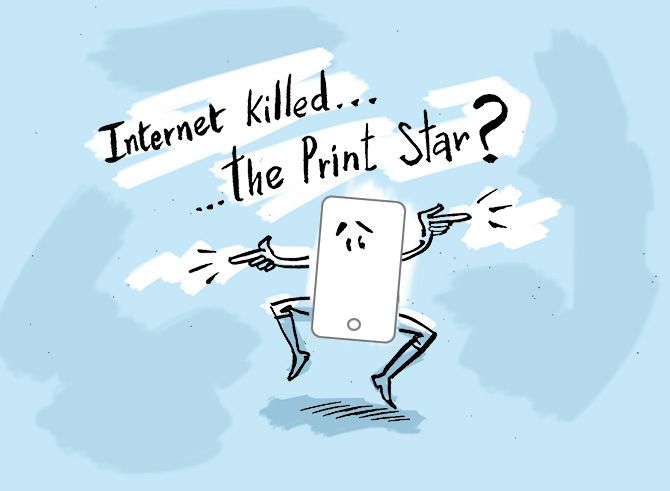Or a brief stop on the way to better times, asks Ajit Balakrishnan.

The extended, multi-month lockdown has meant that in most parts of the world there have been no printed newspapers to go with our morning coffee or printed magazines to laze with over our week-ends or new printed books to drift with into imagined worlds.
Print newspapers and magazines are dependent on not just physical delivery to homes, but also shops and stalls being open for people to pick them up.
In addition, advertisers in many categories, such as travel, themselves facing a crisis in their revenues, have shut down advertising, an essential lifeline for all media, but more so for print newspapers and magazines.
Is it that the long tortuous path that has been the fate of print media ever since the arrival of the Internet in the late 1990s is now coming to an end?
In the early 1960s, when nylon and polyester cloth first arrived and anyone with even the faintest sense of fashion rushed to adopt polyester fabric-based trousers and nylon sarees, it appeared that cotton as dress material was doomed, but now people have swung back to cotton clothing.
Nylon saris and polyester fabric clothing are now the sure signal of being classified as a provincial.
While it is common to hail all technological innovations as a sign of modernisation and progress that will never be reversed, a closer look at history shows us that this may not be always true.
One such 'modernising' movement that rose, flourished for decades and then fell is pesticides, in particular, DDT.
Created by Swiss chemist Paul Hermann Müller right before World War II, DDT was credited with halting outbreaks of then widely prevalent deadly diseases like typhus and malaria.
After the war, it gained a name as a wonder chemical. In the post-World War II period and for the next 20 years, millions of tonnes of DDT were produced and used throughout the world to control insects in agricultural fields.
DDT was then adopted by the World Health Organization for a programme designed to 'eradicate' malaria worldwide and it recommended that small quantities of DDT inside people's homes would kill or repel the mosquitoes bearing the malarial parasite.
When this campaign started in India, more than half a million people were dying every year from malaria. In the next 10 years, deaths due to malaria in India were eliminated.
The onward march of synthetic pesticides and chemicals was seen as the great forward march of scientific progress.
Then came Rachel Carson's book Silent Spring, describing how DDT, once sprayed, persisted in the environment and how it passed from one species to another up the food chain destroying entire species. The book is credited with fostering the environmental movement and with prompting the US and other governments to ban DDT in 1972.
DDT became 'chemical non grata.' As DDT use diminished, malaria kicked back, killing several million people a year, mostly young children in Africa.
DDT and similar synthetic chemicals are back in use, but what Carson's movement set in motion was the environmentalist movement -- and with it we saw the rise of organic foods.
As you can see, complex technical and social processes work their way to cause the rise and fall of new technologies.
Learning from this, it is important to trace the societal processes through which print media has had to struggle through.
The first blow to print media was in the early 2000s when the Internet was just getting under way, when Internet sites offering to run matrimonial, jobs, travel and apartment-for-rent ads for free started eroding classified advertising that often was half of all advertising revenue for newspapers and magazines.
The 'free' offers from Internet sites that also had quickly acquired sizeable audiences was, of course, made possible by another development: The emergence of venture capital funds ready to fund the losses of these Internet media ventures. This continues to this day.
Print newspapers and magazines throughout the world, however, are owned and managed by third generation family owners who don't have the technology backgrounds needed to come up with a new vision.
What are the societal forces that create almost zero-cost capital to come into being and be extensively deployed worldwide? The origin of this, of course, is in the US, where a super-influential financial services community lobbies and gets a near zero interest-rate regime using the argument that near-zero interest rates allow business to get capital cheap and create jobs.
This, of course, is far from being true. The small business owner will get capital, almost never from a bank, but from a financial capitalist who will take a stake in his business.
These phenomena have taken the Internet into completely new directions and made it a toy for the financial community to play with.
However, a current phenomenon that mystifies me is the trend in computer programming books and Web sites, both of which, I must confess, I am an avid consumer of. When a new programming technique or technology appears, the creators post some tantalising tidbits on their own and other tech websites.
The full-fledged details are available only if you engage them as consultants, or attend a paid training programme online or offline that they conduct, or, hold your breath, buy a printed book they have coauthored and usually heftily priced $35 a copy or more.;
So, is the world of print media waiting for its Rachel Carson? Or is it waiting for new entrepreneurs who will bring innovation to the industry?
Ajit Balakrishnan (ajitb@rediffmail.com), founder and CEO, Rediff.com/em>, is an Internet entrepreneur and chaired a committee set up by the ministry of human resource development on education and entrepreneurship last year to provide inputs for the National Education Policy.












 © 2025
© 2025